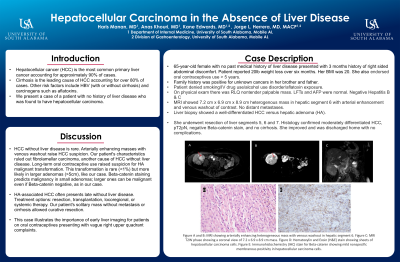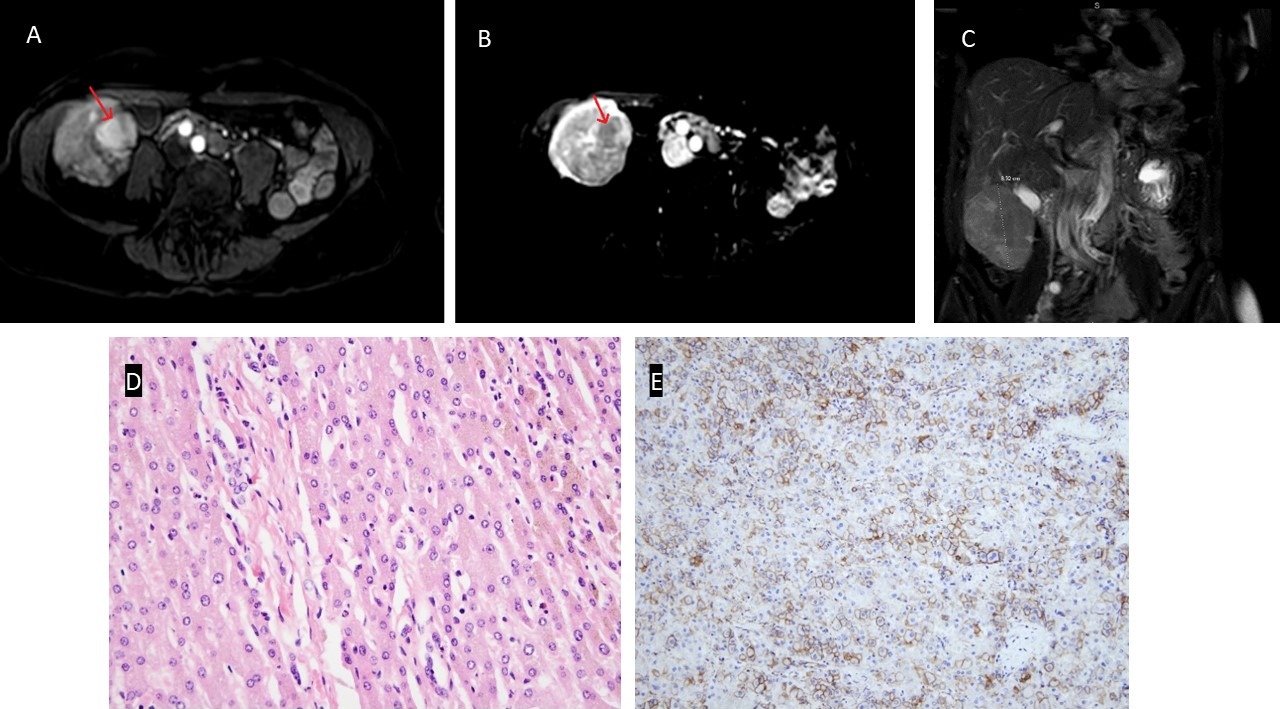Monday Poster Session
Category: Liver
P2531 - Hepatocellular Carcinoma in the Absence of Liver Disease
Monday, October 23, 2023
10:30 AM - 4:15 PM PT
Location: Exhibit Hall

Has Audio

Haris Manan, MD
University of South Alabama
Mobile, AL
Presenting Author(s)
Haris Manan, MD1, Anas Khouri, MD1, Kane Edwards, MD2, Jorge L. Herrera, MD, MACG2
1University of South Alabama, Mobile, AL; 2USA Health, Mobile, AL
Introduction: Hepatocellular cancer (HCC) is the most common primary liver cancer accounting for approximately 90% of cases. Cirrhosis is the leading cause of HCC accounting for over 80% of cases. Other risk factors include HBV (with or without cirrhosis) and carcinogens such as aflatoxins. We present a case of a patient with no history of liver disease who was found to have hepatocellular carcinoma.
Case Description/Methods: 65-year-old female with no history of liver disease presented with right sided abdominal discomfort for 3 months. She had a family history of unknown cancers in her brother and father. BMI was 21 and she reported 20lb weight loss over six months. Chronic use of oral contraceptives for many years was noted. No smoking, IV drug use, alcohol use disorder, or aflatoxin exposure. RLQ was nontender with palpable mass on exam. Normal LFTs and AFP levels. Negative Hepatitis B and C. MRI showed 7.2 cm x 6.9 cm x 8.9 cm heterogenous mass in hepatic segment 6 with arterial enhancement and venous washout of contrast. Liver biopsy showed a well-differentiated HCC versus hepatic adenoma (HA). No distant metastasis. She underwent resection of liver segments 5, 6 and 7. Histology confirmed moderately differentiated HCC, pT2pN, negative -catenin stain, and no cirrhosis. She improved and was discharged home with no complications.
Discussion: Development of HCC without liver disease is rare. Presence of an arterially enhancing mass with venous washout is highly suspicious for HCC. Our patient’s age, radiologic and histologic characteristics of the lesion excluded fibrolamellar carcinoma HCC, a known cause of HCC in the absence of liver disease. Long-term oral contraceptives’ use raised the possibility of malignant transformation of a HA. Transformation of a HA to HCC is rare (< 1%) and is more common in larger adenomas >5cm such as in our case. -catenin staining in adenomas predicts high risk of malignancy in lesions < 5cm in size, but larger adenomas may become malignant even if -catenin negative. Due to the absence of liver disease, HA-associated HCC tends to present late in the disease process. Management options include resection, transplantation, locoregional therapy or systemic therapy. Our patient had a solitary mass without metastasis or cirrhosis making her a candidate for curative resection. This case illustrates the importance of early liver imaging for patients on oral contraceptives with vague right upper quadrant complaints.

Disclosures:
Haris Manan, MD1, Anas Khouri, MD1, Kane Edwards, MD2, Jorge L. Herrera, MD, MACG2. P2531 - Hepatocellular Carcinoma in the Absence of Liver Disease, ACG 2023 Annual Scientific Meeting Abstracts. Vancouver, BC, Canada: American College of Gastroenterology.
1University of South Alabama, Mobile, AL; 2USA Health, Mobile, AL
Introduction: Hepatocellular cancer (HCC) is the most common primary liver cancer accounting for approximately 90% of cases. Cirrhosis is the leading cause of HCC accounting for over 80% of cases. Other risk factors include HBV (with or without cirrhosis) and carcinogens such as aflatoxins. We present a case of a patient with no history of liver disease who was found to have hepatocellular carcinoma.
Case Description/Methods: 65-year-old female with no history of liver disease presented with right sided abdominal discomfort for 3 months. She had a family history of unknown cancers in her brother and father. BMI was 21 and she reported 20lb weight loss over six months. Chronic use of oral contraceptives for many years was noted. No smoking, IV drug use, alcohol use disorder, or aflatoxin exposure. RLQ was nontender with palpable mass on exam. Normal LFTs and AFP levels. Negative Hepatitis B and C. MRI showed 7.2 cm x 6.9 cm x 8.9 cm heterogenous mass in hepatic segment 6 with arterial enhancement and venous washout of contrast. Liver biopsy showed a well-differentiated HCC versus hepatic adenoma (HA). No distant metastasis. She underwent resection of liver segments 5, 6 and 7. Histology confirmed moderately differentiated HCC, pT2pN, negative -catenin stain, and no cirrhosis. She improved and was discharged home with no complications.
Discussion: Development of HCC without liver disease is rare. Presence of an arterially enhancing mass with venous washout is highly suspicious for HCC. Our patient’s age, radiologic and histologic characteristics of the lesion excluded fibrolamellar carcinoma HCC, a known cause of HCC in the absence of liver disease. Long-term oral contraceptives’ use raised the possibility of malignant transformation of a HA. Transformation of a HA to HCC is rare (< 1%) and is more common in larger adenomas >5cm such as in our case. -catenin staining in adenomas predicts high risk of malignancy in lesions < 5cm in size, but larger adenomas may become malignant even if -catenin negative. Due to the absence of liver disease, HA-associated HCC tends to present late in the disease process. Management options include resection, transplantation, locoregional therapy or systemic therapy. Our patient had a solitary mass without metastasis or cirrhosis making her a candidate for curative resection. This case illustrates the importance of early liver imaging for patients on oral contraceptives with vague right upper quadrant complaints.

Figure: Figure A and B: MRI showing arterially enhancing heterogeneous mass with venous washout in hepatic segment 6.
Figure C: MRI T2W phase showing a coronal view of 7.2 x 6.9 x 8.9 cm mass.
Figure D: Hematoxylin and Eosin (H&E) stain showing sheets of hepatocellular carcinoma cells.
Figure E: Immunohistochemistry (IHC) stain for Beta-catenin showing mild nonspecific membranous positivity in hepatocellular carcinoma cells.
Figure C: MRI T2W phase showing a coronal view of 7.2 x 6.9 x 8.9 cm mass.
Figure D: Hematoxylin and Eosin (H&E) stain showing sheets of hepatocellular carcinoma cells.
Figure E: Immunohistochemistry (IHC) stain for Beta-catenin showing mild nonspecific membranous positivity in hepatocellular carcinoma cells.
Disclosures:
Haris Manan indicated no relevant financial relationships.
Anas Khouri indicated no relevant financial relationships.
Kane Edwards indicated no relevant financial relationships.
Jorge Herrera indicated no relevant financial relationships.
Haris Manan, MD1, Anas Khouri, MD1, Kane Edwards, MD2, Jorge L. Herrera, MD, MACG2. P2531 - Hepatocellular Carcinoma in the Absence of Liver Disease, ACG 2023 Annual Scientific Meeting Abstracts. Vancouver, BC, Canada: American College of Gastroenterology.

